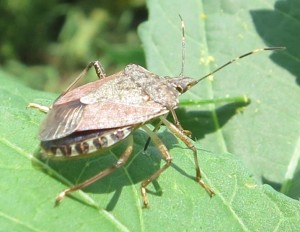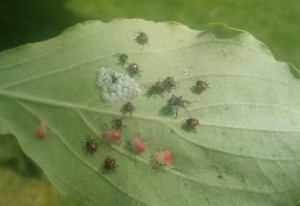
BMSB on okra (photo from Dr. Frank Hale, Extension Entomologist, University of Tennessee, Nashville)
In recent years Brown Marmorated Stink Bug (Halyomorpha halys), aka BMSB, has become serious pests of fruits, vegetables, and farm crops in the Mid-Atlantic and Southern Appalachian regions. BMSB are likely to spread to other areas in the U.S. They feed on all parts of plants (fruit, stems, leaves). They may also become a major nuisance invader in our homes, particularly in the fall.
BMSB are classified as a “true bug” (order-Hemiptera), native to China, Japan, and Korea. Adults are approximately 2/3-inch long and in shades of grayish brown. Their backs display the typical “shield” shape of other stink bugs. Masses of 20 to 30 eggs elliptical shaped eggs are light yellow to yellow-red, attached side-by-side to the underside of leaves.
BMSB have one generation per year in the Mid-Atlantic and Southern Appalachian regions. In a mild year, warm spring and summer conditions, count on the development of two generations. Adults will emerge in the spring, mate, and deposit eggs from May through August. The eggs hatch into small black and red nymphs that go through five molts (instars). Adults search for overwintering sites, including house walls and insulation, in late September through October.
Fruit crops include apples, peaches, plums, figs, blackberries, mulberries, citrus, and persimmons. Infested vegetables include sweet and field corn, tomatoes, lima beans, green peppers and soybeans. Some landscape plants are also damaged. BMSB scar the skin surface of apples and peaches, referred to as “cat facing,” and renders fresh fruits unmarketable.
BSMB cause no harm to humans, but the bugs enter homes as “accidental invaders” and can become an odorous nuisance. They get inside and don’t leave. They will not reproduce or cause structural indoor damage. They are best swept up in a vacuum cleaner, sometimes multiple times a week. Smashing several bugs will explain their name, as their foul smell may become quite apparent.
To keep stink bugs from entering homes and buildings, seal cracks around windows, doors, siding, et al. with silicone or latex caulk. Screens on doors and windows should be properly maintained. People may carry them indoors on the clothes.
Exterior applications of any synthetic pyrethroid insecticide in the fall may reduce insect numbers, but these products have only a short residual life. Two or three applications per week may be warranted. Insecticides should not be sprayed indoors. Read and closely follow the pesticide label.


 Posted in
Posted in 
